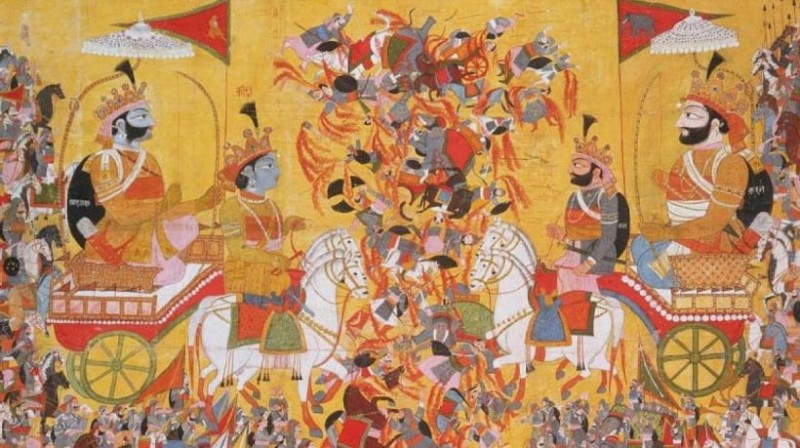
In Hindu cosmology, time is believed to be cyclical, consisting of four distinct ages known as Yugas. Dvapara Yuga is the third in this sequence, following the Satya Yuga and Treta Yuga. It is an age of transition and transformation, characterized by shifts in human consciousness and significant events that shape the course of history.
Meaning and Significance of Dvapara Yuga
Dvapara Yuga is often referred to as the "Bronze Age." It is an epoch of increased duality and complexity, where the virtuous qualities of the Satya Yuga and Treta Yuga begin to wane. However, the spiritual essence remains prevalent, creating opportunities for growth and redemption.
Duration and Characteristics of Dvapara Yuga
According to Vedic scriptures, each Yuga has a specific duration. Dvapara Yuga spans for 864,000 years, with its own unique characteristics and qualities. Astrologically, it is associated with the precession of the equinoxes and the transition from the age of Pisces to Aquarius.
Astrological beliefs
Many astrologers and spiritualists believe that the transition from one Yuga to another brings about significant shifts in human consciousness and societal dynamics. The influence of the planets and celestial bodies is said to play a crucial role during this age.
Spiritual aspects
Dvapara Yuga is considered a crucial period for spiritual growth and understanding. It is believed that during this age, spiritual practices, rituals, and devotion to the divine become more accessible to humanity.
Legends and Events in Dvapara Yuga
The most significant event during Dvapara Yuga is the epic of Mahabharata, which narrates the great Kurukshetra War. This monumental battle between the Pandavas and Kauravas, along with Lord Krishna's divine guidance, showcases the triumph of righteousness over evil.
The Mahabharata epic
The Mahabharata, an ancient Indian epic, is not just a tale of war but a treasure trove of wisdom, philosophy, and moral teachings. It contains valuable life lessons and insights into human nature, making it a timeless literary masterpiece.
Lord Krishna's incarnation
One of the most revered incarnations of Lord Vishnu, Lord Krishna, descended to Earth during Dvapara Yuga. His teachings in the Bhagavad Gita remain a guiding light for spiritual seekers and those seeking to fulfill their duties with devotion.
Shift from Treta Yuga to Dvapara Yuga
The transition from Treta Yuga to Dvapara Yuga marks a turning point in the Yuga cycles. It represents a gradual shift in human behavior, values, and societal norms, reflecting the changes in human consciousness as they move away from a more virtuous age.
Comparison with Other Yugas
To understand Dvapara Yuga better, let's briefly compare it to the other Yugas.
Satya Yuga
Satya Yuga, also known as the "Golden Age," is the first Yuga characterized by righteousness, truth, and spiritual enlightenment. It is an age of harmony, where divine principles govern human conduct.
Treta Yuga
Treta Yuga is the second age, known as the "Silver Age." In this era, the virtue and truth of Satya Yuga decline slightly, leading to the introduction of religious ceremonies and sacrifices.
Kali Yuga
Kali Yuga, the last and current Yuga, is an age of darkness and ignorance, where spiritual values are at their lowest point. It is marked by increased materialism and moral degradation.
Cultural and Religious Impact of Dvapara Yuga
The events and legends of Dvapara Yuga have had a profound influence on Hindu culture and spirituality. The Mahabharata continues to inspire countless generations with its timeless teachings and ethical dilemmas faced by its characters.
The Concept of Yugas in Modern Times
While the Yugas are deeply rooted in Hindu cosmology and spirituality, their significance extends beyond religious beliefs. Many contemporary thinkers and scholars interpret the Yugas as symbolic representations of the cyclical nature of human history and consciousness.
Understanding the Cycles of Time
Vedic cosmology offers a unique perspective on time cycles and cosmic order. The concept of Yugas is not limited to Hinduism alone; similar ideas can be found in other ancient cultures as well.
Vedic cosmology
According to Vedic beliefs, the universe undergoes cyclical patterns of creation and dissolution. Each Yuga represents a phase in this cosmic cycle, with specific characteristics and attributes.
Yuga cycles in Hinduism
The Yuga cycles are part of a more extensive time measurement system in Hinduism, reflecting the repetitive nature of existence and the continuous evolution of human consciousness.
Significance of Dharma in Dvapara Yuga
Dharma, the moral and ethical duties, plays a pivotal role during Dvapara Yuga. As the world becomes more complex, individuals are faced with challenging situations that demand moral clarity and righteous actions.
Spiritual Practices and Wisdom in Dvapara Yuga
During Dvapara Yuga, spiritual practices and wisdom teachings become more accessible to people. Sages, gurus, and enlightened beings impart knowledge and guide seekers on the path of spiritual growth. Dvapara Yuga, the age of transition, holds immense significance in Hindu cosmology and spirituality. It is a time of transformation, spiritual opportunities, and profound historical events. The legends and teachings from this age continue to inspire and guide humanity on its eternal quest for truth and enlightenment.
Timeless Marvels: Discovering the Oldest Temples of India
Sushil Sachdeva: A Trailblazer's Odyssey in Business and Benevolence